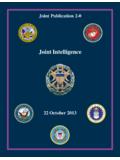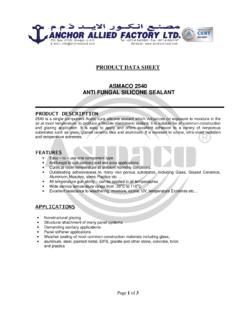Transcription of ALLIED JOINT LOGISTIC DOCTRINE AJP-4(A)
1 ALLIED JOINT LOGISTIC DOCTRINE AJP-4(A) DECEMBER 2003 AJP-4(A) Original I AJP-4(A) ALLIED JOINT LOGISTIC DOCTRINE DECEMBER 2003 AJP-4(A) Original iv RECORD OF CHANGES Change Date Date Entered Effective Date By Whom Entered AJP-4(A) Original v CHAPTER RECORD OF RESERVATION BY NATIONS 1 2 3 4 AJP-4(A) Original vii RESERVED FOR NATIONAL LETTER OF PROMULGATION AJP-4(A)
2 Original ix FOREWORD The successful planning, execution and support of military operations requires a clearly understood DOCTRINE , and this is especially important when operations are to be conducted by ALLIED , multinational or coalition forces. ALLIED JOINT Publication-01 (AJP-01) provides the capstone DOCTRINE for the planning, execution and support of ALLIED JOINT operations. Although AJP-01 is intended primarily for NATO forces, the DOCTRINE could be applied, with adaptations where necessary and agreed by participating nations, for operations under the umbrella of the European Union (EU), or a coalition of NATO and non-NATO nations within the framework of a Combined JOINT Task Force (CJTF). Thus no distinctions are drawn within the document between solely NATO operations, non-Article 5 Crisis Response Operations (CRO) by ALLIED forces and CJTF operations. The revisions in the LOGISTIC JOINT and multinational keystone DOCTRINE AJP-4 (A) ALLIED JOINT LOGISTIC DOCTRINE include: All chapters and sections have been rewritten to be more logical readable and coherent.
3 Where possible, text has been slimmed and reference made to supporting documents. NATO LOGISTIC Support Concept is now a part of the document, and consistent with NATO s overall policies on logistics. Defence and Operational Planning1 has been more clearly delineated. LOGISTIC functional areas have been selected and focused on operational logistics. NATO s relationship to the European Union is incomplete, awaiting political decision. If it is to be useful, AJP-4 has to be a living document and be amended regularly. Under the auspices of the BI-SC Logistics Co-ordination Board (Bi-SC LCB), the Bi-SC LCB DOCTRINE Committee (Bi-SC LCB DC), will review and up-date AJP-4(A) as deemed appropriate. Therefore, change proposals are welcome at anytime. They can be sent to either the SC s Logistics Branches or to the Co-chairmen of the Bi-SC LCB DC. A future AJP-4(B) will aim at a further harmonisation with all sub-documents.
4 1 France is not part of the Defence planning process AJP-4(A) Original xi TABLE OF CONTENT CHAPTER 1 - THE ALLIANCE S CONCEPT OF LOGISTIC SUPPORT Section I - Introduction Page Purpose 1-1 Applicability 1-1 Scope 1-2 Principles 1-2 Section II - NATO s LOGISTIC Support Concept Aim 1-5 NATO LOGISTIC Support Concept 1-5 Co-ordination of National and Multinational LOGISTIC Activities 1-5 LOGISTIC Planning from a Multinational and JOINT Perspective 1-6 Synchronisation of Procedures in the LOGISTIC Functional Areas 1-6 Implementation of the Concept 1-6 Component Support Concepts 1-6 Maritime 1-6 Land 1-7 Air 1-8 Roles and Responsibilities 1-8 LOGISTIC Support Considerations 1-13 Section III - Combined and JOINT LOGISTIC Command and Control Introduction 1-16 Operational Considerations 1-16 Command, Control and Co-ordination 1-17 LOGISTIC Information Systems and Tools 1-19 Annex 1-A ALLIED JOINT LOGISTIC DOCTRINE Hierarchy 1-23 Annex 1-B - Roles and Responsibilities 1-25 CHAPTER 2 - LOGISTIC SUPPORT PLANNING Section I - Introduction Introduction 2-1 Types of Planning 2-1 Section II The Role of LOGISTIC Planning in the Defence Planning Process Defence Planning 2-1 Defence Planning Disciplines 2-1 References 2-2 AJP-4(A)
5 Original xii Page Force Planning 2-2 Logistics Planning 2-3 Armaments, Resource and CIS Planning 2-4 Relationship between Defence Planning and Operational Planning 2-4 Section III - LOGISTIC Support Planning for Operations Aim 2-5 References 2-5 NATO Operational Planning Process 2-5 Section IV - LOGISTIC Planning Conferences Introduction 2-7 Product of LOGISTIC Planning Conferences 2-7 LOGISTIC Planning Conferences 2-7 Section V LOGISTIC Planning Considerations Introduction 2-9 Movement Planning for Operations and Exercises 2-10 Medical Planning for Operations and Exercises 2-10 HNS Planning 2-11 Infrastructure Planning 2-11 Contracting and Funding 2-11 Contributions of Non-NATO Nations 2-11 Concluding the Operation 2-11 Accounting for and Disposal of NATO Owned Equipment 2-12 LOGISTIC Evaluation and Assessment 2-13 Certification of Non-NATO Troop Contingents 2-13 Section VI Co-operation and Co-ordination with non-NATO
6 Organisations Co-ordination with Non-Governmental Organisations 2-13 LOGISTIC Co-operation with the European Union 2-13 LOGISTIC Co-operation with the United Nations 2-14 LOGISTIC Co-operation with the Organisation for Security and Co-operation in Europe 2-14 CHAPTER 3 - LOGISTIC FUNCTIONAL AREAS Section I - Introduction 3-1 Section II Supply and Service Function Supply 3-1 Provision of Supplies 3-1 Multinational Provision 3-1 Supply Transaction Procedures 3-2 Stock Level Management 3-2 Asset Tracking 3-2 Petroleum, Oils and Lubricants (POL) 3-2 Service Function 3-3 AJP-4(A) Original xiii Page Multinational Provision of Services 3-3 Section III Maintenance and Repair Function Maintenance and Repair 3-3 Section IV Movement and Transportation Function Movement and Transportation 3-5 Characteristics 3-5 Levels of Mobility 3-5 Modes of Transport 3-5 Intermodality 3-6 Section V - Infrastructure Function General 3-6 Infrastructure Provision 3-6 NATO Security Investment Program (NSIP)
7 Projects 3-6 Section VI - Medical Function General 3-7 Medical C2 Structure 3-7 Evacuation 3-7 Aeromedical Evacuation 3-8 Section VII Contracting Function General 3-8 NATO Co-ordination 3-8 Organisation 3-8 Section VIII - Budget and Finance Function Article 5- General 3-9 Non-Article 5 Crisis Response- General 3-9 Common Funding Eligibility 3-9 Constraints on Common Funding Eligibility 3-10 Proposals for Exceptions 3-10 Forecast of Funding Requirements 3-10 Centralised Support of National/Multinational Projects 3-10 Funding Restrictions 3-11 Organisation and responsibilities 3-11 Annex 3-A Classes of Supply 3-14 Glossary of Abbreviations Abbreviations-1 Glossary of Terms & Definitions Glossary-1 Reference Publications References-1 AJP-4(A) Original 1-1 CHAPTER 1 THE ALLIANCE S CONCEPT OF LOGISTIC SUPPORT Section I - Introduction 0101. NATO LOGISTIC and support concepts have been established in response to changing national force structures and NATO s evolving enhanced mission spectrum.
8 The concepts take into account: a. Non-Article 5 Crisis Response Operations (CRO) that require additional LOGISTIC support for both deployment and operations beyond NATO s Area of Responsibility (AOR). b. The need to implement the MC 319/1 principle of collective responsibility for LOGISTIC support. c. The need to operate logistically with non-NATO forces. d. The need to maximise efficiency and cost effectiveness of LOGISTIC support. e. The emergence of multinational structures such as Multinational JOINT LOGISTIC Centre (MJLC), Lead Nation (LN), Role Specialist Nation (RSN), Multinational Integrated LOGISTIC Unit (MILU) and Third Party LOGISTIC Support Services (TPLSS). 0102. Purpose. The purpose of this document is to establish NATO s overall LOGISTIC support DOCTRINE . It details NATO LOGISTIC principles and policies, with an operational level2 focus, to foster common understanding and co-operative LOGISTIC planning among NATO military authorities (NMA), nations and NATO agencies.
9 This NATO LOGISTIC support DOCTRINE is the basis for the conduct of multinational LOGISTIC operations and serves to facilitate the NATO commander in the achievement of his mission. 0103. Applicability a. This document is applicable to peace and the full spectrum of potential NATO operations (Article 5 as well as non-Article 5 CRO) from crisis through conflict. While much of the DOCTRINE is focused toward the more probable scenarios of mid-intensity and non-Article 5 CRO, the DOCTRINE is equally applicable to other operations. b. This document is applicable to NATO operations including those conducted in co-operation with the United Nations (UN), the European Union (EU), and the Organisation for Security and Co-operation in Europe (OSCE). It is also applicable for non-NATO nations participating in NATO led operations. 2 Operational level of war: The level of war at which campaigns and major operations are planned, conducted and sustained to accomplish strategic objectives within theatres or areas of operations.
10 (AAP-6(2002)) AJP-4(A) Original 1-2 0104. Scope. While the NATO definition of logistics is wide ranging, this publication deals mainly with planning and co-ordination of NATO operational LOGISTIC support. Specifically, the focus is on the functional areas of: Supply and services Maintenance and repair Movement and transportation Infrastructure Medical Contracting Funding Additionally, this publication covers broad LOGISTIC responsibilities such as Host Nation Support (HNS). The ALLIED JOINT LOGISTIC DOCTRINE Hierarchy is described in Annex 1-A. 0105. Principles. In order for the NATO commander to execute his responsibilities for logistics efficiently, certain LOGISTIC principles must be observed. These must be in line with the General Principles for JOINT and Combined Operations, as defined in AJP-01, and must also be consistent with those LOGISTIC principles presented in MC 319/1, MC 326/1, MC 334/1 and MC 336/2.




